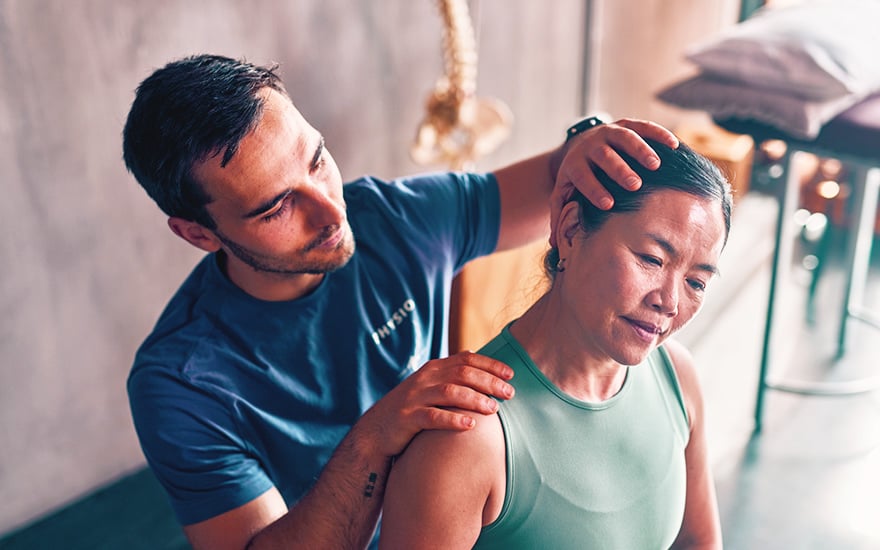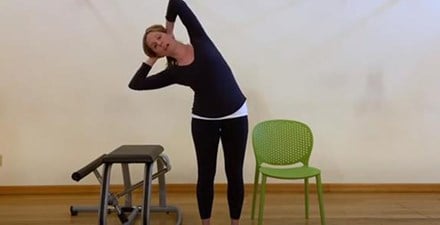Physical Therapy Guide to Neck Pain
Neck pain is pain felt in the back of the neck – the upper spine area, just below the head. When certain nerves are affected, the pain can extend beyond the back of the neck to areas such as the upper back, shoulder, and arm. Neck pain can be caused by sudden trauma such as a fall, sports injury, or car accident, or by long-term problems in the spine.
Neck pain most frequently affects adults aged 30 to 50 years. Some studies indicate that women are more likely to suffer neck pain than men. Poor posture, obesity, smoking, repetitive lifting, office and computer work, and involvement in athletic activity are all risk factors for developing neck pain.
People with neck pain can have difficulty performing activities such as working, driving, playing sports, or simply turning their heads. The majority of neck pain episodes do not require surgery and respond best to physical therapy. Physical therapists design individualized treatment programs to help people with neck pain reduce or eliminate pain, regain normal movement, and get back to their regular activities.
Physical therapists are movement experts. They improve quality of life through hands-on care, patient education, and prescribed movement. You can contact a physical therapist directly for an evaluation. To find a physical therapist in your area, visit Find a PT.
How Does It Feel?
People with neck pain may experience stiffness in the neck, and may describe the pain they feel as:
- Sharp.
- Stabbing.
- Dull.
- Aching.
- Throbbing.
- Tingling.
Neck pain caused by irritated nerves may extend into the upper back, shoulder blades, shoulders, arms, or hands. This condition is called "radiculopathy." Your physical therapist can help determine if this condition is occurring, and will work closely with your physician and surgeon to determine the correct treatment.
Signs and Symptoms
The type and location of your symptoms depend on the tissue or structure that is affected, and the severity of the injury.
Neck pain can cause any of the following signs:
- Inability to bend or rotate the neck.
- Difficulty looking up.
- Difficulty looking over the shoulder.
- Weak arm and shoulder muscles.
- Muscle spasms.
Neck pain can cause any of the following symptoms:
- Pain in the neck, upper back, shoulders, arms, or hands.
- Numbness or tingling in the neck, shoulders, arms, or hands.
- Weakness in the arms.
- Increased pain when coughing, sneezing, reaching, or sitting.
- Inability to stand straight or sit up straight.
- Stiffness when trying to move, or a feeling of being "stuck" in a position such as stooped forward, or with the head leaning to the side.
- Tight muscles.
- Headaches.
- Inability to remain in one position for a long period of time, such as sitting or standing, due to pain.
- Pain that is worse in the morning or at night.
- Difficulty sleeping due to pain.
How Is It Diagnosed?
Your physical therapist will conduct a thorough examination that includes taking your health history. He or she will also ask you detailed questions about your pain or injury, such as:
- How and when did the pain start?
- What type of discomfort do you feel, and where do you feel it?
- At what time of day is it worse?
- What can’t you do right now in your daily life due to the pain?
Your physical therapist will perform tests on your body to find physical problems, such as:
- Difficulty moving.
- Weakness or tightness in the muscles.
- Loss of skin sensation (numbness) in some areas.
- Loss of reflexes.
- Joint stiffness.
- Poor posture.
- Difficulty walking.

If your physical therapist finds any of the above problems, physical therapy treatment may begin right away to help get you on the road to recovery and back to your normal activities.
If more severe problems are found with any of the testing, your physical therapist may collaborate with a physician or surgeon to obtain special diagnostic testing, such as an MRI. Your physical therapist will work closely with physicians and other health care providers to make sure that you receive an accurate diagnosis and the treatment and care you need.
How Can a Physical Therapist Help?
Recent research has shown that early physical therapy can help people manage neck pain, and reduces the need for long-term medication use (such as opioids). Physical therapy treatments also can sometimes help people avoid the need for surgery or medication altogether by improving mobility and strengthening muscles to support the neck and spine.
Your physical therapist will work with you to design a specific treatment program that will speed your recovery, including exercises and treatments that you can do at home. Physical therapy can help you return to your normal lifestyle and activities.
The time it takes to heal each condition varies, but an individualized physical therapy program can be effective and efficient, and help heal neck pain in a matter of weeks.
Your physical therapist may advise you to:
- Rest the painful area by avoiding activity that causes worsening symptoms in the neck or arms.
- Stay active around the house, avoid prolonged bed rest, and go on short walks several times per day. Movement will decrease pain and stiffness, and help you feel better.
- Perform the simple neck movements he or she will teach you. These can help reduce stiffness and pain and restore normal motion of the neck.
- Apply moist heat or ice packs to the affected area for 15 to 20 minutes every 2 hours.
- Sit in firm chairs. Soft couches and easy chairs may make your problems worse.
- Consult with a physician for further services, such as medication or medical tests.
Your physical therapist will work with you to:
Reduce pain and other symptoms. Your physical therapist will help you understand how to avoid or modify the activities that caused the injury, so healing can begin. He or she may use different types of treatments and technologies to control and reduce your pain and symptoms. These may include gentle hands-on techniques, known as manual therapy, that he or she will perform for you; specific neck movements that you will be taught to perform yourself; and the use of technologies, such as electrical stimulation or traction, as required. Physical therapists examine each person individually to determine exactly what type of approach will help reduce pain.
Avoid surgery. In most cases, a physical therapist can design an individualized treatment program to help relieve neck pain—even severe radiculopathy (pain that travels from the neck down into the arm or hand)—to help individuals with neck pain avoid surgery. In rare cases, radiculopathy requires surgery to relieve its cause.
Improve posture. If your physical therapist finds that poor posture has contributed to your neck pain, he or she will teach you how to improve your posture so healing can occur.
Improve motion. Your physical therapist will choose specific activities and treatments to help restore normal movement in any stiff joints. These might include "passive" motions that the physical therapist performs for you to move your spine, or active exercises and stretches that you do yourself. You can perform these motions at home, in your workplace, and before your sports activities to help hasten healing and pain relief.
Improve flexibility. Your physical therapist will determine if any of the involved muscles are tight, and teach you gentle stretching exercises that you can perform at home. He or she also may supervise your performance of special stretches during your physical therapy treatments.
Improve strength. If your physical therapist finds any weak or injured muscles, he or she will choose and teach you the correct exercises to gently restore your strength and agility. For neck pain, "core strengthening or stabilization" is commonly used to restore the strength and coordination of muscles around your spine.
Improve endurance. Restoring muscular endurance is important for people with neck pain. Your physical therapist will develop a program of activities to help you regain the endurance you had before the neck pain started.
Learn a home program. Your physical therapist will teach you strengthening, stretching, and pain-reduction exercises to perform at home. These exercises will be specific for your needs. If you do them as prescribed by your physical therapist, you can speed your recovery.
Return to Activities. Your physical therapist will discuss your activity levels with you and use them to set your work, sport, and home-life recovery goals. Your treatment program will help you reach your goals in the safest, fastest, and most effective way possible. For spine problems like neck pain, your physical therapist may teach you correct ways to lift objects (called "body mechanics") that will help protect your spine from further injury.
As your neck pain is improving, it will be important for you to continue your new posture and movement habits to keep your neck healthy and pain free.
Following Surgery
In rare cases of neck pain, surgery is necessary to relieve pressure on a nerve or on the spinal cord. If you undergo surgery, your physical therapist will work closely with you and your surgeon to help you regain motion and strength more quickly than you could on your own, and help you return to your daily activities as quickly as possible.
Can This Injury or Condition Be Prevented?
To prevent neck pain, people should:
- Maintain good posture (avoid slouching) at all times. That means keeping the spine and head in proper alignment during sitting, standing, and all daily activities.
- Keep your muscles strong and flexible. Participate in a consistent program of physical activity to maintain a healthy fitness level.
- Use proper body mechanics when lifting, pushing, pulling, or performing any action that puts extra stress on your spine.
- Maintain a healthy weight. This will reduce the stress on your spine.
- Stop smoking.
- Discuss your occupation with a physical therapist, who can provide an analysis of your job tasks and offer suggestions for reducing your risk of injury.
To prevent recurrence of neck pain, follow the above advice, and:
- Continue the new posture and movement habits that you learned from your physical therapist to keep your back healthy.
- Continue to do your home-exercise program as taught to you by your physical therapist. This will help maintain your improvements.
- Continue to be physically active and stay fit.
What Kind of Physical Therapist Do I Need?
All physical therapists are prepared through education and experience to treat people who have neck pain. You may want to consider:
- A physical therapist who is experienced in treating people with orthopedic, or musculoskeletal, problems.
- A physical therapist who is a board-certified clinical specialist or who completed a residency or fellowship in orthopedic physical therapy. This physical therapist has advanced knowledge, experience, and skills that may apply to your condition.
You can find physical therapists who have these and other credentials by using Find a PT, the online tool built by the American Physical Therapy Association to help you search for physical therapists with specific clinical expertise in your geographic area.
General tips when you’re looking for a physical therapist:
- Get recommendations from family and friends or from other health care providers.
- When you contact a physical therapy clinic for an appointment, ask about the physical therapists' experience in helping people with neck pain.
- Be prepared to describe your symptoms in as much detail as possible, and say what makes your symptoms worse.
The American Physical Therapy Association believes that consumers should have access to information that could help them make health care decisions and also prepare them for their visit with their health care provider.
The following articles provide some of the best scientific evidence related to physical therapy treatment of a neck pain. The articles report present research and give an overview of the standards of practice for treatment both in the United States and internationally. The article titles are listed by year and linked either to a PubMed* abstract of the article or to free full text, so that you can read it or print out a copy to bring with you to your health care provider.
Alpayci M, İlter S. Isometric exercise for the cervical extensors can help restore physiological lordosis and reduce neck pain: a randomized controlled pain. Am J Phys Med Rehabil. 2017 January 23 [Epub ahead of print]. Article Summary in PubMed.
Meziat-Filho N, Azevedo E Silva G, Coutinho ES, et al. Association between home posture habits and neck pain in high school adolescents. J Back Musculoskelet Rehabil. 2017;30:467–475. Article Summary in PubMed.
Bussières AE, Stewart G, Al-Zoubi F, et al. The treatment of neck pain-associated disorders and whiplash-associated disorders: a clinical practice guideline. J Manipulative Physiol Ther. 2016;39:523–564.e27. Article Summary in PubMed.
Kim EK, Kim JS. Correlation between rounded shoulder posture, neck disability indices, and degree of forward head posture. J Phys Ther Sci. 2016;28:2929–2932. Article Summary in PubMed.
Ris I, Søgaard K, Gram B, et al. Does a combination of physical training, specific exercises and pain education improve health-related quality of life in patients with chronic neck pain: a randomised control trial with a 4-month follow up. Man Ther. 2016;26:132–140. Article Summary in PubMed.
Zronek M, Sanker H, Newcomb J, Donaldson M. The influence of home exercise programs for patients with non-specific or specific neck pain: a systematic review of the literature. J Man Manip Ther. 2016;24:62–73. Article Summary in PubMed.
Halvorsen M, Falla D, Gizzi L, et al. Short- and long-term effects of exercise on neck muscle function in cervical radiculopathy: a randomized clinical trial. J Rehabil Med. 2016;48:696–704. Free Article.
Cohen SP. Epidemiology, diagnosis, and treatment of neck pain. Mayo Clin Proc. 2015;90:284–299. Article Summary in PubMed.
Pierre Langevin, François Desmeules, Mélanie Lamothe, et al. Comparison of 2 manual therapy and exercise protocols for cervical radiculopathy: a randomized clinical trial evaluating short-term effects. J Orthop Sports Phys Ther. 2015;45:4–17. Article Summary in PubMed.
Peolsson A, Söderlund A, Engquist M, et al. Physical function outcome in cervical radiculopathy patients after physiotherapy alone compared with anterior surgery followed by physiotherapy: a prospective randomized study with a 2-year follow-up. Spine (Phila Pa 1976). 2013;38:300–307. Article Summary in PubMed.
Keramat KU, Gaughran A. Safe physiotherapy interventions in large cervical disc herniations. BMJ Case Rep. 2012;2012:bcr2012006864. Article Summary in PubMed.
Boyles R, Toy P, Mellon J, et al. Effectiveness of manual physical therapy in the treatment of cervical radiculopathy: a systematic review. J Man Manip Ther. 2011;19:135–142. Article Summary in PubMed.
Cook C, Hegedus EJ, Ramey K. Physical therapy exercise intervention based on classification using the patient response method: a systematic review of the literature. J Man Manip Ther. 2005;13:152–162. Article Summary in PubMed Health.
Sun EMoshfegh JRishel CACook CEGoode APGeorge SZ. Association of Early Physical Therapy With Long-term Opioid Use Among Opioid-Naive Patients With Musculoskeletal Pain. JAMA Netw Open. 2018;1(8):e185909. Article Summary in PubMed.
*PubMed is a free online resource developed by the National Center for Biotechnology Information (NCBI). PubMed contains millions of citations to biomedical literature, including citations in the National Library of Medicine’s MEDLINE database.
Expert Review:
Jun 20, 2017
Revised:
Jun 20, 2017
Content Type: Guide
Neck Pain
PT, DPT
The editorial board
You Might Also Like...
Health Tips
Dry Needling by a Physical Therapist: What You Should KnowMay 31, 2024
Dry needling is a technique that some physical therapists use to treat pain and movement impairments. It is not the same as acupuncture. Learn how physical
Health Tips
Tips for Healthy Cycling From Physical TherapistsMay 6, 2022
Cycling is a repetitive activity, that can lead to discomfort or pain. If you have pain related to cycling, you might have a bike fit problem. These tips
Video
Exercise Posture Break for Office WorkersJun 3, 2020
A physical therapist led posture break with exercises to do several times daily for people who spend most of their workday sitting at a computer.


